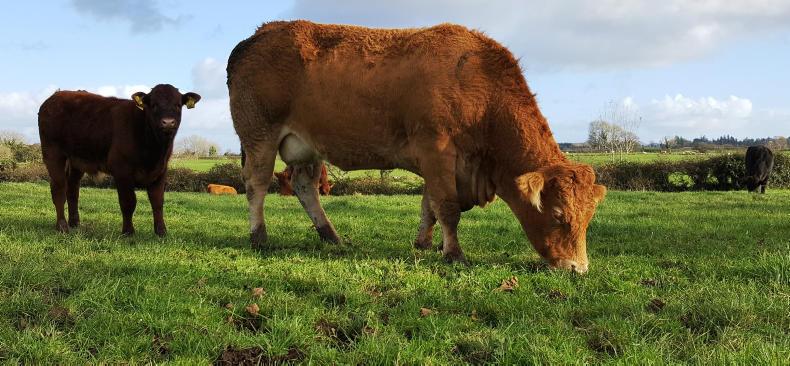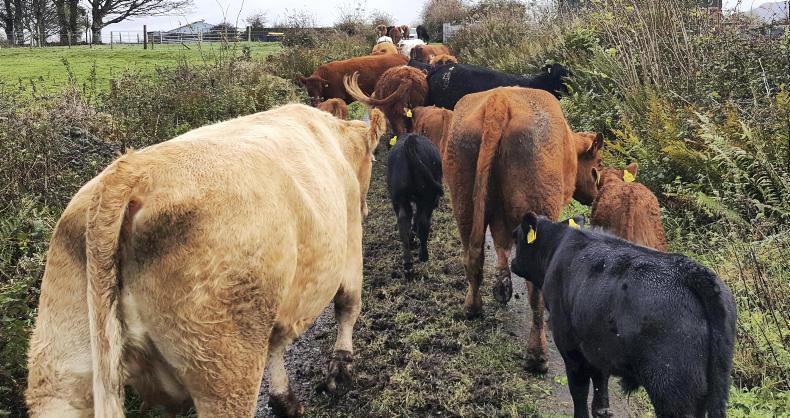When the clocks fall back an hour at this time of year, as a part-time farmer calving suckler cows in the autumn, it’s becomes time to house cows and young calves.
There’s no comfort, when after a days work, checking cows and calves in darkness with a torch or mobile phone light for assistance.
The last two weeks have shown a marked improvement in weather and ground conditions which meant that cows and calves received an extra week at grass this year compared to last year.
Many farmers have managed to get the last of the silage harvested, unfortunately there is not the option to empty slatted tanks.
Breeding season
The start of the breeding season for me is the middle of October, which means I have now three weeks complete before housing.
Moving towards a tighter calving spread means that the majority of cows have been submitted for AI before housing, which should help with conception rates.
The change in environment from outdoors to inside and the associated change in diet from grass to silage can upset a cows reproductive cycle, so for the last week outdoor cows had access to silage at a feeding barrier in an attempt to minimise the disruption.

The oldest calves are now two to three months old and have access to graze paddocks next to the cows. Coccidiosis in calves is a disease that I need to be very vigilant for and I use a simple drench dose as a preventive measure.
The effects are long lasting and I believe limit a calf’s full potential to gain maximum weight.
Calf welfare
Calves will continue to have access to paddocks throughout the winter with a bedded creep area for lying in at night.
They will also receive additional silage and meal to maximise potential weight gain.
Silage samples have been sent for testing and unless it is of very poor quality cows will not receive any meal during the winter.
This year’s batch of calves are a much more even bunch than other years.
In terms of age and weight there are huge advantages as all treatments such as de-horning and vaccinations are carried out at the same time.
Similarly there is no need to pen cows or calves separately from their comrades.
This may arise where you don’t want calves of different ages mixing or cows at different stages of the reproductive cycle mixing.
While the majority of farmers calve cows in the spring as cows head out to grass, autumn calving is my preferred system and a system that suits my workload.
As with any system, each year is an attempt to improve on the previous year.
Read more
More from Trevor Boland
When the clocks fall back an hour at this time of year, as a part-time farmer calving suckler cows in the autumn, it’s becomes time to house cows and young calves.
There’s no comfort, when after a days work, checking cows and calves in darkness with a torch or mobile phone light for assistance.
The last two weeks have shown a marked improvement in weather and ground conditions which meant that cows and calves received an extra week at grass this year compared to last year.
Many farmers have managed to get the last of the silage harvested, unfortunately there is not the option to empty slatted tanks.
Breeding season
The start of the breeding season for me is the middle of October, which means I have now three weeks complete before housing.
Moving towards a tighter calving spread means that the majority of cows have been submitted for AI before housing, which should help with conception rates.
The change in environment from outdoors to inside and the associated change in diet from grass to silage can upset a cows reproductive cycle, so for the last week outdoor cows had access to silage at a feeding barrier in an attempt to minimise the disruption.

The oldest calves are now two to three months old and have access to graze paddocks next to the cows. Coccidiosis in calves is a disease that I need to be very vigilant for and I use a simple drench dose as a preventive measure.
The effects are long lasting and I believe limit a calf’s full potential to gain maximum weight.
Calf welfare
Calves will continue to have access to paddocks throughout the winter with a bedded creep area for lying in at night.
They will also receive additional silage and meal to maximise potential weight gain.
Silage samples have been sent for testing and unless it is of very poor quality cows will not receive any meal during the winter.
This year’s batch of calves are a much more even bunch than other years.
In terms of age and weight there are huge advantages as all treatments such as de-horning and vaccinations are carried out at the same time.
Similarly there is no need to pen cows or calves separately from their comrades.
This may arise where you don’t want calves of different ages mixing or cows at different stages of the reproductive cycle mixing.
While the majority of farmers calve cows in the spring as cows head out to grass, autumn calving is my preferred system and a system that suits my workload.
As with any system, each year is an attempt to improve on the previous year.
Read more
More from Trevor Boland







 This is a subscriber-only article
This is a subscriber-only article










SHARING OPTIONS: